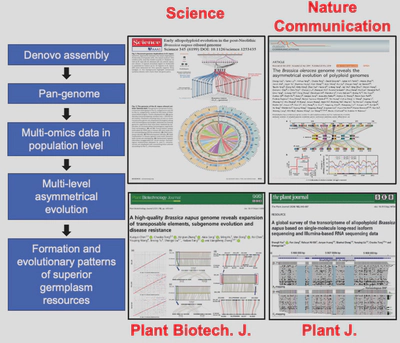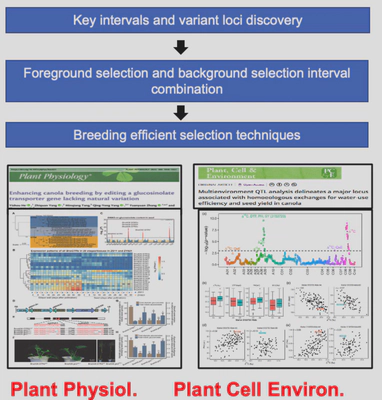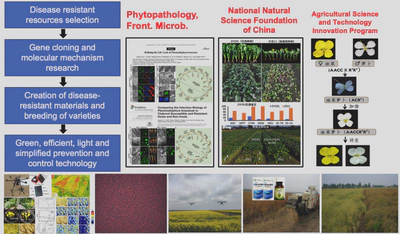Research
1. Evolution of Polyploid Genomes in Brassicaceae
Together with other coordinators (Boulos Chalhoub, Xiaowu Wang, Ian Bancroft, Isobel Parkin, Andy Paterson, Graham King, Chris Pires, Rod Snowdon), we coordinated assembling of the international reference genomes of Brassica napus and its progenitors B. rapa and B. oleracea (Nature Genetics, 2011, 43:1035-1039. doi: 10.1038/ng.919; Nature Communications, 2014, 5:3930. doi: 10.1038/ncomms4930; Science, 2014, 345: 950-953. doi: 10.1126/science.1253435). From the comparative studies of these individual genomes and Arabidopsis, we found asymmetry of subgenomes in transposable element expansion, gene loss, amplification of tandemly duplicated genes and generation of alternative splicing variants. This finding stimulated questions and inspired us to address key question of why recurrent WGDs occur and how diploidization after polyploidization links to biodiversity and speciation, and what is a different breeding strategy of polyploid crops from old diploids (relative stable diploidized genome). To this end and further explore the asymmetrical evolution, we have focused on population genomics and produced an array of genomic resource. For example, chromosome-level genome assemblies of a dozen of B. napus accessions using long reads from third generation sequencing technologies; an aligned pangenome from 2880 Brassica napus accessions constructed using the above assemblies and high in-depth Illumina short reads; a library of B. napus reference transcripts by long read sequencing to precisely map transcripts (reducing cross mapping due to similar duplicate sequences), and further alternative splicing transcripts of a subpopulation comprising 300 representative accessions; a set of 3D genomes and epigenomes. Using these genomic resources, we have been studying subgenome evolution and diploidization from SNP, SV, recombination, homoeologous exchange, gene conversion, and their impact on trait variation and selection.

2. Breeding by Genome Design (BGD)/Synthetic Biology
Connected with the genome resource and ideas from the above genome evolution studies, the BGD objectives are to not only select expected traits by molecular markers (fore-ground selection), but also to do hybridization parent design and offspring selection for shortening breeding period and elite cultivars. For the objectives, we have been performing the following studies: (1) phenotyping a large number of accession population; (2) generating multiple omics data, i.e. population metabolome and those mentioned above of population genomes and transcriptomes and spliceome; (3) mapping of loci controlling important traits based on SNP, SV, gene expression and alternative splicing transcripts; (4) investigation on genome evolution of a large number of accessions and pedigrees for genome design; (5) genome editing for some traits required. These together enable us to conduct fore- and back-ground selection for selecting and synthesizing an expected germplasm or elite cultivar. By developing the technological strategy and searchable and comparable database platform, we aim to create novel germplasm and breeding ideal plant type with short plant, high yield, earliness and resistance to main diseases Sclerotinia and clubroot. Now we have we created a series of germplasm resources for breeding, e.g. the high glucosinolate content in vegetative tissues but low in seeds.
In addition, we have also been working on development of “conventional” breeding method that is specific for polyploid crops and different from those used currently in diploid and polyploid crops.

3. Brassica Disease Resistance and Molecular Mechanisms
One of our commitments is to develop Brassica resistance germplasm/varieties and study its genes and molecular mechanisms. In the past 30 years, we developed most resistant B. napus lines against Sclerotinia sclerotiorum and released these lines to breeders and other researchers in the world. In recent years, in response to rapeseed production demand, we have focused on identification/development and molecular mechanism study of lines/cultivars with earliness and resistance to Sclerotinia disease and lines/cultivars with resistance to clubroot caused by Plasmodiophora brassicae that has become epidemic in recent years. Now we found several major Sclerotinia-resistant loci are tightly liked with early flowering, and two genes identified among the loci are eventually pleiotropic, and thus provided a strategy for gene editing and hybridization combination. And fortunately, we identified three immune materials (from B. napus, Raphanus sativus and Arabidopsis thaliana) with broad-spectrum resistance to all P. brassicae races/biotypes by large-scale screening according to the principles of evolution and plant-pathogen interactions, and now the three loci have been fine mapped (one dominant and two recessive) and two target genes have been cloned.
4. Green, cost-saving and sustainable control of major Brassica diseases
We have been making contribution to crop production in the task by developing Sclerotinia-resistant lines (e.g. Liu et al. Plant Cell Reports, 2005, 24: 133-144. doi: 10.1007/s00299-005-0925-0) and providing insight into resistance/pathogenesis (e.g. Liu et al. Phytopathology, 2020, 110:1704-1712. doi: 10.1094/PHYTO-02-20-0029-R), and particularly we first introduced remote drone into fungicide spray to control Sclerotinia disease, which solved the difficulty of hand-operation spray at B. napus flowering stage, and now this technique has been widely used for many crops for many kinds of spray and even for seeding. Now we are developing multiple disease-resistant varieties with earliness as well as optimising spray parameters of remote drone in collaboration with drone engineers. With these as major measures, an integrated disease management is developed and timely updated.
